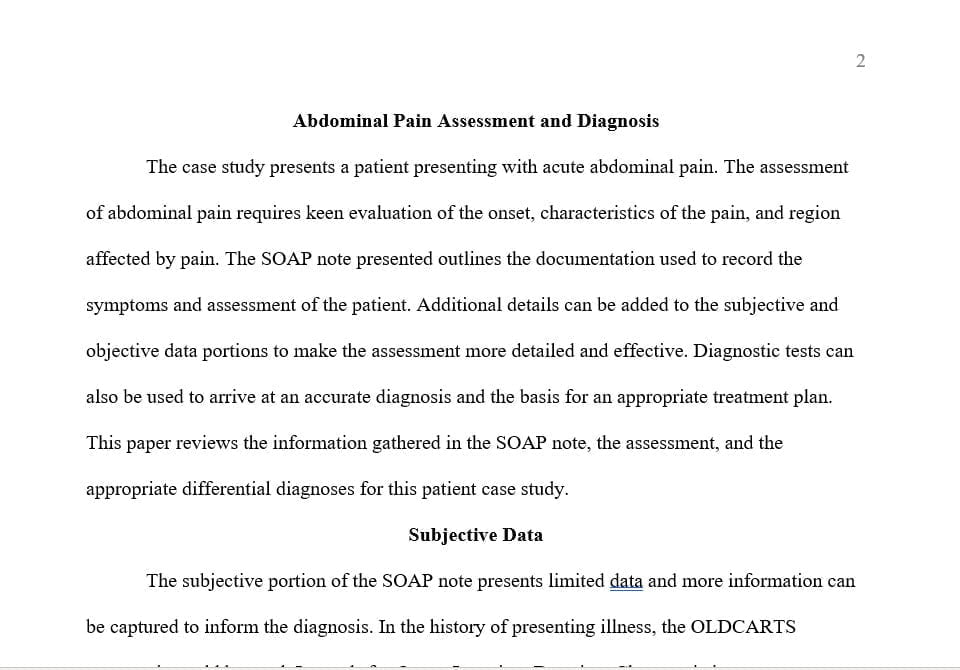A male went to the emergency room for severe midepigastric abdominal pain.
A male went to the emergency room for severe midepigastric abdominal pain.
A male went to the emergency room for severe midepigastric abdominal pain. He was diagnosed with AAA ; however, as a precaution, the doctor ordered a CTA scan.
Because of a high potential for misdiagnosis, determining the precise cause can be time consuming and challenging. By analyzing case studies of abnormal abdominal findings, nurses can prepare themselves to better diagnose conditions in the abdomen.
In this Lab Assignment, you will analyze an Episodic note case study that describes abnormal findings in patients seen in a clinical setting. You will consider what history should be collected from the patients as well as which physical exams and diagnostic tests should be conducted. You will also formulate a differential diagnosis with several possible
ABDOMINAL ASSESSMENT
Subjective:
- CC: “My stomach hurts, I have diarrhea and nothing seems to help.”
- HPI: JR, 47 yo WM, complains of having generalized abdominal pain that started 3 days ago. He has not taken any medications because he did not know what to take. He states the pain is a 5/10 today but has been as much as 9/10 when it first started. He has been able to eat, with some nausea afterwards.
- PMH: HTN, Diabetes, hx of GI bleed 4 years ago
- Medications: Lisinopril 10mg, Amlodipine 5 mg, Metformin 1000mg, Lantus 10 units qhs
- Allergies: NKDA
- FH: No hx of colon cancer, Father hx DMT2, HTN, Mother hx HTN, Hyperlipidemia, GERD
- Social: Denies tobacco use; occasional etoh, married, 3 children (1 girl, 2 boys)
Objective:
- VS: Temp 99.8; BP 160/86; RR 16; P 92; HT 5’10”; WT 248lbs
- Heart: RRR, no murmurs
- Lungs: CTA, chest wall symmetrical
- Skin: Intact without lesions, no urticaria
- Abd: soft, hyperactive bowel sounds, pos pain in the LLQ
- Diagnostics: None
Assessment:
- Left lower quadrant pain
- Gastroenteritis
- Analyze the subjective portion of the note. List additional information that should be included in the documentation.
- Analyze the objective portion of the note. List additional information that should be included in the documentation.
- Is the assessment supported by the subjective and objective information? Why or why not?
- What diagnostic tests would be appropriate for this case, and how would the results be used to make a diagnosis?
- Would you reject/accept the current diagnosis? Why or why not? Identify three possible conditions that may be considered as a differential diagnosis for this patient. Explain your reasoning using at least three different references from current evidence-based literature.
TO PREPARE
Review the Episodic note case above.
- With regard to the Episodic note case study provided:
- Review this week’s Learning Resources, and consider the insights they provide about the case study.
- Consider what history would be necessary to collect from the patient in the case study.
- Consider what physical exams and diagnostic tests would be appropriate to gather more information about the patient’s condition. How would the results be used to make a diagnosis?
- Identify at least five possible conditions that may be considered in a differential diagnosis for the patient.
LEARNING RESOURCES
- Ball, J. W., Dains, J. E., Flynn, J. A., Solomon, B. S., & Stewart, R. W. (2019). Seidel’s guide to physical examination: An interprofessional approach (9th ed.). St. Louis, MO: Elsevier Mosby.
- Chapter 18, “Abdomen”
In this chapter, the authors summarize the anatomy and physiology of the abdomen. The authors also explain how to conduct an assessment of the abdomen.
- Chapter 18, “Abdomen”
- Dains, J. E., Baumann, L. C., & Scheibel, P. (2019). Advanced health assessment and clinical diagnosis in primary care (6th ed.). St. Louis, MO: Elsevier Mosby.
Credit Line: Advanced Health Assessment and Clinical Diagnosis in Primary Care, 6th Edition by Dains, J.E., Baumann, L. C., & Scheibel, P. Copyright 2019 by Mosby. Reprinted by permission of Mosby via the Copyright Clearance Center. - Chapter 3: This chapter outlines how to collect a focused history on abdominal pain. This is followed by what to look for in a physical examination in order to make an accurate diagnosis.
- Chapter 10: The focus of this chapter is on identifying the causes of constipation through taking a focused history, conducting physical examinations, and performing laboratory tests.
- Chapter 12: In this chapter, the authors focus on diagnosing the cause of diarrhea. The chapter includes questions to ask patients about the condition, things to look for in a physical exam, and suggested laboratory or diagnostic studies to perform.
- Chapter 29: This chapter focuses on how to diagnose rectal bleeding and pain. It includes a table containing possible diagnoses, the accompanying physical signs, and suggested diagnostic studies.
- Chapter 115: X-RAY interpretation of the abdomen
- Colyar, M. R. (2015). Advanced practice nursing procedures. Philadelphia, PA: F. A. Davis.
Credit Line: Advanced practice nursing procedures, 1st Edition by Colyar, M. R. Copyright 2015 by F. A. Davis Company. Reprinted by permission of F. A. Davis Company via the Copyright Clearance Center.
Answer preview for the paper on ‘A male went to the emergency room for severe midepigastric abdominal pain.’

APA 1276 Words
